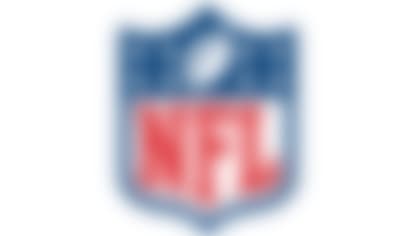Every year, it seems youth is served sooner -- and more often -- in the NFL draft.
The Jan. 15 deadline for underclassmen to declare has become more important, as the top of the draft board is increasingly shaped by their decisions.
Through most of the past 20 years, an average of four to six of the top-10 selections did not exhaust their collegiate eligibility. But last year at Radio City Music Hall, eight of the first 10 names read by NFL Commissioner Roger Goodell were underclassmen. The first round has become much less senior-centric overall. The 1990s saw an average of nine underclassmen landing in Round 1, and at least 15 underclassmen were selected in the opening round in each of the past three drafts.
Don't look for the 2012 draft class to reverse this trend. There are two dozen juniors and redshirt sophomores with a chance of becoming a first-round pick in April. They'll likely dominate the very top of the draft, as well, with six to eight likely coming off the board in the first 10 picks.
It's important to note that there are many declaring underclassmen who might not push their way into the first round, but are still highly capable of enjoying fruitful careers. Some may be pushed out of the first round due to team needs or simply the position they play. For example, running backs Lamar Miller (Miami) and David Wilson (Virginia Tech) are very talented, as are tight ends Dwayne Allen (Clemson) and Orson Charles (Georgia), but few players at those positions make it into the top 32 picks anymore.
The players listed below are squarely in NFL general managers' sights as they prepare to invest millions on what they hope is a major piece of their team's future.
Top of the board
Andrew Luck, QB, Stanford Between now and the April draft, the 10 interceptions Luck threw in 2011 -- particularly those thrown against Oregon and USC -- will be overanalyzed. Don't be fooled -- NFL teams know the son of former pro quarterback (and current West Virginia Athletic Director) Oliver Luck was simply born to play on Sundays. He already boasts an elite combination of physical and mental attributes.
Robert Griffin III, QB, Baylor: The extreme importance of the quarterback position makes RG3 the second-most valued player in the draft. He'll continue to impress scouts and general managers with his intelligence, confidence, athleticism, strong arm and deep-ball accuracy in the pre-draft buildup. So much so that one team may end up trading a number of picks to jump ahead of the quarterback-needy Cleveland Browns and acquire Griffin, despite his average size and the fact he missed most of his sophomore season with a right knee injury.
Top-five value
Matt Kalil, OT, USC The brother of Carolina Panthers center Ryan Kalil is making his own name among scouts, with his tall, athletic, still-growing frame filling the prototype of a blind-side pass protector. With multiple teams in the top 10 needing help at his position, Kalil will be highly valued.
Morris Claiborne, CB, LSU Though not as formidable a physical specimen as former LSU teammate and impressive Arizona Cardinals rookie Patrick Peterson, Claiborne has plenty of size and speed to handle NFL receivers outside and has displayed the receiver-like ball skills to make quarterbacks pay for mistakes. He should be the first defensive prospect selected.
Justin Blackmon, WR, Oklahoma State The two-time Biletnikoff Award winner as the nation's top receiver had 3,304 receiving yards and 38 touchdowns over the past two years. His 186 yards and three scores in the Cowboys' win over Stanford in the Fiesta Bowl again showed scouts his strong running and reliable hands, as well as the speed to be a vertical threat and not just a strong red-zone presence.
Top-10 value
Riley Reiff, OT, Iowa The junior left tackle is a strong run blocker and has the potential to be a solid pass protector on either the left or right side as he continues to work on his technique. Iowa's linemen have a pretty good reputation among NFL offensive line coaches, and Reiff has better athleticism than the Hawkeyes' last first-round tackle prospect, Bryan Bulaga, who went 23rd overall to Green Bay two years ago.
Dre Kirkpatrick, CB, Alabama Kirkpatrick is the highest-rated player on the Tide's top-rated defense. He's well over six-feet tall, has very long arms and likes to make big hits when supporting against the run or making receivers pay for catching passes in front of him. The junior still has to prove to scouts that he has elite straight-line speed, but even if his 40-yard dash at the combine is average, Kirkpatrick has shown himself to be physical and long enough to stay with any receiver down the sideline.
Trent Richardson, RB, Alabama Richardson did not win a Heisman Trophy like his former Alabama teammate and 2011 first-round pick Mark Ingram, but his rushing numbers this past season (1,679 yards, 21 touchdowns) actually bested those of the injured Saints back in his award-winning 2009 campaign (1,658, 17 TD). Richardson appears to have superior speed to Ingram because of his burst in the open field. And the fact he can catch the ball out of the backfield and stay in the game to pick up blitzes makes him a complete back. But injuries are so prevalent at the position that teams may be reluctant to use a top-10 pick to secure his services.
Michael Brockers, DT, LSU Most 6-foot-6 defensive tackles struggle to stay low inside. But against Alabama in the BCS Championship Game, the redshirt sophomore not only anchored against double-teams, but also got off the blocks to make plays (in addition to getting his big hand up to block a field-goal attempt). It was a bit of a surprise that he decided to leave Baton Rouge after three years, but his upside as an athletic terror in the middle of a defense could push him into the top-10 overall selections.
Top-20 value
David DeCastro, OG, Stanford The Cardinal consistently ran behind DeCastro the past three seasons, whether he was controlling his man in-line or using his above-average mobility to lead the way upfield or around one of his tackles. Stanford also relied on him to keep all-everything quarterback Luck from feeling interior pressure. He may not be quite as athletic as the Pouncey twins, Maurkice and Mike, who were both first-round picks in the past two drafts, but he has the potential to be among the best guards in the NFL early in his career.
Jonathan Martin, OT, Stanford Team needs could push Martin ahead of DeCastro, and maybe some others listed above, because he has a lot of traits teams look for in a long-time starter at the crucial tackle position: intelligence, strength, and a nasty streak. He did a pretty good job keeping Luck's blind side clean over the past couple of seasons, but his overall athleticism is not elite, leading some scouts to wonder if he'll be able to consistently handle the speed of NFL defensive ends. Nevertheless, expect Martin to be picked early and have a good pro career.
Whitney Mercilus, DE, Illinois Don't be surprised if Mercilus (conveniently pronounced like "merciless") also creeps up boards throughout the draft process. He wore the same No. 85 jersey that 49ers' super-rookie pass rusher Aldon Smith sported at Missouri, and has a similar build and feel to his game. Though not quite as strong or explosive as Smith, a strong combine and an utter lack of pass rushers with length in this draft could push up his stock as April approaches.
Luke Kuechly, ILB, Boston College The Eagles' defensive leader nearly set a NCAA career record for tackles in three years. He followed up a 183-tackle sophomore year with 191 stops in 2011, making him one of the most productive linebackers in college football history. His instincts and football IQ are more coveted than his athleticism, but don't tell opposing ball carriers that he lacks the quickness to attack plays all over the field.
Alshon Jeffery, WR, South Carolina Jeffery is one of the more intriguing -- and frustrating -- players in this draft. He lumbers downfield at times, and consistency has been an issue during his career. The 6-foot-4, 230-pound receiver's ability to win jump balls in the end zone and down the sideline, however, may trump any other issues for teams in the mid-to-late first-round area. Remember that most did not expect current Falcons rookie Julio Jones to light up the combine with a great 40 time, either; Jeffery could earn himself a lot of money with a 40-yard dash time in even the low-to-mid 4.5's in Indianapolis.
Nick Perry, DE/OLB, USC Perry burst on the scene in 2009 with six sacks in his first four games. His sophomore season was a bit uneven -- thanks to a nagging ankle injury -- but he bounced back strong in 2011 by leading the Pac-12 with 9.5 sacks. When healthy, Perry's quickness off the line is formidable; 4-3 teams looking for a "wide nine" defensive end will like what he brings to the field, and it is easy to see defensive coordinators using a lot of three-man fronts standing him up on the edge. And again, the lack of pure pass-rush talents in this draft only increases his value.
Playoff-team targets
Peter Konz, C, Wisconsin Like DeCastro, Konz often led the way for a strong running game from inside, as well as protected a very valuable quarterback in Russell Wilson during the 2011 season. He missed three games with a dislocated left ankle, but scouts saw enough of his strong anchor, excellent quickness off the snap and mobility belying his NFL-caliber size to grade him as a first-round pick.
Fletcher Cox, DT, Mississippi State Cox flashed power and quickness throughout his junior season, taking guards into the backfield at times and getting skinny through gaps to attack plays. His strength is not consistent, as he has a somewhat svelte build, but he has the agility to be a five-technique defensive end in a 3-4 scheme (if the 4-3 teams in the middle of the first round question whether he'll be stout enough inside).
Jerel Worthy, DT, Michigan State Worthy is a more typical defensive tackle prospect who can play with strength at the line of scrimmage and beat his man off the snap with a swipe of his violent hands. He does not make a lot of plays outside the box and disappears for parts of games, but playoff teams looking to take a chance on Worthy's ability to develop into a quality three-down NFL starter may feel the risk of a mid-to-late first-round pick is worth the potential reward.
Dontari Poe, DT, Memphis The Tigers' mammoth 6-foot-5, 350-pound junior defensive lineman doesn't wow you with great stats (eight tackles for loss, one sack in 2011). But few prospects his size can move along the line as he does, playing anywhere coaches put him. With his astounding agility, he affect many more plays than he's given credit for on the score sheet. NFL defensive coaches will see a raw, late-first-round talent from which they could mold a potential difference-maker somewhere on their front line.



